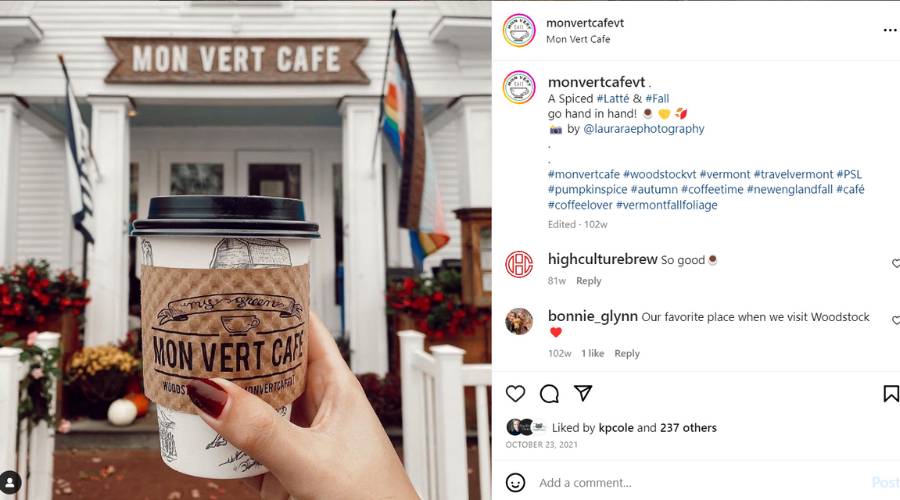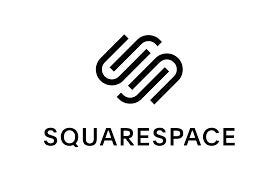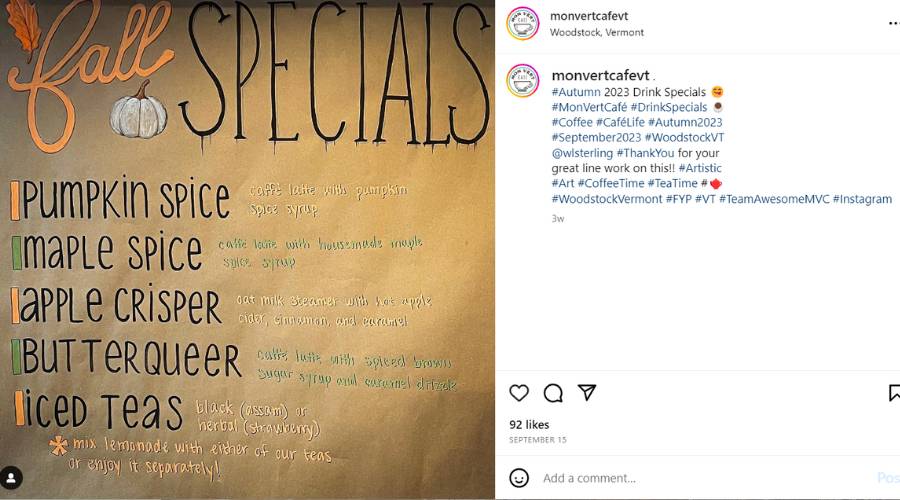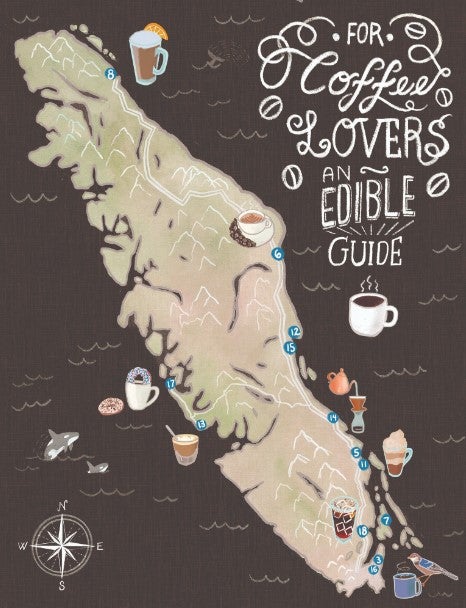Coffee should be easy to sell; it’s delicious, the aroma is enchanting, and drinking coffee is a daily ritual for many people. But to attract new customers and build long-term loyalty that gives independent coffee shops longevity, you need excellent coffee shop marketing. Your coffee shop marketing strategy needs to increase brand awareness, drive foot traffic, boost sales, and nurture loyalty. The best marketing for coffee shops also engages with the surrounding community.
I’ve managed multiple coffee programs over the years (DM me for my pumpkin spice syrup recipe) and have seen a lot of successful cafe marketing strategies. Here are my best coffee shop marketing ideas to help your coffee shop draw a crowd.
1. Get a Sharp Sign
Customers can’t buy your coffee if they can’t find you. Sometimes a good, highly visible sign is all a potential customer needs to see before they start craving a cup of java. If you do nothing else, make sure you have an easy-to-read, highly visible, and enticing sign to drive customers to your shop.

2. Develop a Loyalty Program
Coffee and loyalty are a natural fit since coffee (and other caffeinated beverages) are a daily habit for consumers. In fact, three out of four Americans drink at least one coffee a day. A robust loyalty program makes it easy for coffee lovers to pick your shop over others. You can go old school and print punch cards that lead to a free drink or another incentive, or you can offer a more complex rewards system with multiple reward levels via loyalty software or a coffee shop point-of-sale (POS) system with built-in loyalty.
A loyalty app is my preferred strategy as it allows you to offer more customizable rewards. Loyalty apps feed customer appetites for personalization (see tip 9) and give you contact information for sending promotions and marketing emails or text messages. Even though you are an independent shop, in most markets you’re competing with popular beverage chains like Starbucks and Panera Bread, both of which have hugely popular, and complex loyalty programs.
3. Create Buzzy Branding
There are a variety of coffee shop styles to attract different customer types. Any coffee shop style can be successful, and ensuring your branding matches your vibe is a great way to attract your target customer. For example, Mon Vert Cafe in Woodstock, Vermont, is a classic coffee shop serving locally sourced food and beverages in a historic New England tourist destination. Its branding (pictured below) features classic fonts with elegant, line-drawn illustrations of local ingredients and local landmarks like barns and covered bridges.

4. Set Up a Website
If your coffee shop is small or located in a small market, you might think you don’t need a website. But a coffee shop website is the key to customers finding your shop online. About 29% of US small businesses didn’t have a website in 2024. Of those who lacked a website, about 40% said they didn’t want one, and 26% don’t like the costs associated.
A coffee shop website gives you an address on the internet that search engines can find. You don’t need to hire a web designer or do anything elaborate (though you can if you want). A simple WordPress or Squarespace site listing your hours of operation, a sample menu, and some high-resolution images of your space and drinks is plenty for most customers. With 98% of consumers using the internet to find new businesses, adding a coffee shop website is smart business.
Having an existing website also increases your flexibility. If you have an existing website, you can quickly expand into ecommerce or online ordering as your business grows or when you need to add new revenue streams.

Squarespace is a leader in beginner-friendly web design tools. Choose from hundreds of templates and customize your design with AI for the perfect look. When you’re ready to start selling beans and merch online, Squarespace makes it easy to build a web store, accept payments, scale your marketing efforts, and grow. Visit Squarespace.
5. Optimize for Local Search
Search engine optimization (SEO) may sound complicated. All SEO means is organizing your online business information in a way that Google and search engines can easily find you. SEO for a coffee shop should ensure that your business appears at the top of the list when prospective customers search online for “coffee shop” and “coffee shop near me.” The easiest way to do this is to create a Google Business Profile and ensure it is updated with your correct and current information, like your street address, menu, and hours of operation.
Additionally, you should optimize your website with keywords like “best coffee shop near [your city]” in website headers, footers, or other locations that are readable by search engines. If you earn any local awards like readers’ choice in your town, make sure that news is on your website, as that is just another data point showing search engines your coffee shop’s popularity.
6. Get on Social Media
Instagram is a great platform to showcase your brand, products, and shop story. It is also a terrific way to connect with customers. If you are not on social media, set up your shop’s accounts today. Seriously, right now. I’ll wait. Instagram is vital for coffee shops, with nearly 70% of consumers 18 to 49 using the platform. Depending on your market and your customer demographics, TikTok or Facebook may also be critical.
According to Pew Research, Facebook is most popular, with 75% of 30- to 49-year-olds and 69% of 50- to 64-year-olds using the platform. You’ll also find a majority of urban customers (53%) on Instagram, while more rural social media users (70%) prefer Facebook.
7. Post Engaging Social Media Content
With your social media accounts created, it is important to post regularly (at least once per week, but ideally, one to two times per day) and to post interesting content. Get customers excited about a new beverage by adding a video of how you make it (like this Instagram post from Brū Coffee Bar in Los Angeles).

Show your personality. Post fun stories and images of your shop, feature your team, and give customers a sense of your shop’s atmosphere. Post your seasonal drink menus and talk up your new bakery partner or new menu items. And set aside a few minutes each day to respond to customers when they comment on your posts.
Upload high-quality content. Choose the highest resolution possible for social media images and reels. In some apps, this is done individually on each post. Others have a single “upload at highest quality” setting in the data and privacy settings.
8. Host Social Media Contests
One way to drive engagement on your social media profiles is to host a contest for your followers. Try hosting a giveaway on your social media profiles, requiring entrants to follow your account and tag two friends they want to share a cup of coffee with. Many shops partner with other small businesses and brands to run a giveaway with products from all participating businesses, requiring entrants to like and follow all brands to participate. This can be a great way to increase your visibility with nearby customers who may not have visited your shop.
9. Work With Influencers
When you start looking for coffee shop social media influencers, you’ll find many who post photos for free coffee. If you dig a little deeper, you’ll find influencers that offer streamlined, professional marketing packages with a set number of photos, reels, stories, and posts guaranteed. Many professional influencers give you final approval before posting anything about your brand.
Look for influencers that focus on your town or region; these micro-influencers are less costly. If you are in a tourist location, a higher-profile coffee influencer with more national—or even global—appeal might be worth the money. You can find coffee influencers by searching coffee hashtags on social media platforms or reaching out to influencers on freelancing and marketing sites like Fiverr or Influencer Hero.
10. Offer Coupons
Coupons might seem like a low-tech coffee shop marketing solution, but a 2023 study by Swiftly found that 82% of consumers report using coupons regularly. Physical coupons are great for leaving at the front desk of local hotels, shops, or visitor centers. Digital coupons are great for sending in your email or social media marketing messages. Creating a coupon has never been simpler; you can easily find coupon templates online at sites like Canva or hire a freelance graphic designer to create one for you.

11. Stay on Top of Trends
Latte art. Dalgona coffee. Oat milk lattes. Pour overs. Before they showed up in neighborhood coffee shops, they were trends on social media. Follow coffee enthusiast accounts on Instagram and TikTok and read industry publications like Fresh Cup so you know what trends coffee lovers are talking about and what trends are working for coffee shops like yours. You don’t have to add every new drink you see to your menu, but it’s important to know what is out there so you can jump on the trends that fit your brand or boost your brand visibility by creating menu offerings in response to trends.
12. Host Local Events
Hosting local events like art showings, concerts, literary readings, game nights, or crafting circles is an excellent way to build bonds with your surrounding community. Coffee shops are often viewed as de facto community hangouts, so lean into that idea by hosting local events. For example, First Branch Coffee in South Royalton, Vermont, hosts an “Old-time Music” day on the second Sunday of every month. Local musicians drop in to collaborate and play folk tunes. The popular event drives foot traffic to the shop and has also garnered local press coverage. Building goodwill while earning free advertising? That’s a coffee shop marketing win.

13. Collaborate With Other Businesses
Coffee shops are typically surrounded by other, noncompeting businesses that attract a similar clientele. Working with nearby like-minded brands can draw even more of your target customers to your neighborhood. The type of collaboration will vary based on your location and your coffee service style, but I love the example set by Abracadabra Coffee.

Through the summer, they host popular outdoor events that feature a ton of other small businesses. While a DJ spins tunes, customers shop at a booth from a local vintage store, and multiple food vendors sell everything from pizza to ice cream. Events like these drive sales and also boost brand awareness.
14. Create Seasonal Specials
Starbucks changed the coffee landscape forever when it rolled out the pumpkin spice latte (PSL). The company has sold more than 600 million units of the drink since its introduction in 2003. But the big brands don’t need to have all the fun. Love it or hate it, no coffee shop can ignore the power of the PSL. Consider adding a handful of seasonally inspired beverages to your menu. This might be adding an apple cider to your lineup in the fall and winter or crafting lemonades in the summer. The right seasonal specials can entice new customers to come in for something cravable.

15. Promote Regional Specialties
Specials aren’t just about the seasons. Elevating local ingredients in your brews is a great way to appeal to locals and travelers alike. Promoting local specialties is especially impactful in tourist destinations. Folks traveling to New England want maple syrup, just like those traveling to Florida want oranges. Find unique ways to enhance your beverages with local flavors, whether that is a house-made orange-infused syrup or a maple latte. Regional specialties can also garner national attention if your drink is featured in regional or travel magazines.

If you are located in a popular food destination or a major US city, chances are there is an Edible magazine that covers your area. Check out the Edible Magazine website to introduce your shop to local food journalists.
16. Personalize Marketing Messages
More than 70% of consumers crave personalization from the brands they support. This is never more true than when coffee enters the conversation; coffee drinks are a form of personal expression to many customers. They are not a simple coffee drinker, they are a cold brew drinker or a dry cappuccino fan. They might drink their brews first thing in the morning to jump-start their day, or they might rely on a caffeine hit in the afternoon. Use your knowledge of your customers’ purchasing habits to personalize your email and text message marketing. This is easy to do if your sales data and customer data are stored in the same place, like your POS.

Most modern cloud POS systems include tools for email and text message marketing that can be personalized based on filtered customer lists or custom tags. Set up categories of customers based on past purchases (espresso lovers, tea drinkers, cold brew connoisseurs, etc.) or purchase frequency (VIPs, regulars, rare customers). These POS tools also typically provide customizable message templates that make your email and text message promotions eye-catching.
17. Market on Social Media
You can do more than engage with your customers through social media posts; you can use social media advertising to attract new customers and promote seasonal offerings, merchandise, or a subscription service. Social media advertising is especially useful when you need to move products quickly (like a specialty roast that didn’t sell the way you hoped) or during the holiday season (think gift subscriptions to your coffee of the month club or even digital gift cards).
Instagram and Facebook are obvious choices for coffee shops since foodies tend to gather on those platforms and coffee drinks are photogenic subjects for image and video-based ads. Both platforms are owned by Meta, which allows you to identify detailed customer profiles to focus your advertising efforts and set a budget for each ad so you don’t overspend.

18. Hire a Social Media Agency
If all of this sounds impossible to do alone, consider hiring a social media agency or freelance social media manager. These marketing professionals can create posts, compose content calendars, and run promotions independently. For authenticity, your agency or manager may request photos or unedited video content from you. But they’ll take on the work of editing and adding visuals to make the content stand out.
Retaining the services of a social media marketing agency will cost between $800 and $5,000 per month for a midsize coffee shop. A social media marketing agency can go beyond simply creating and posting content. They can recommend a complete social media marketing plan and construct paid ads that optimize each platform’s algorithms.
Any paid ads would be an additional cost on top of the agency’s fees—from $500 to $1,500 per month. However, paid ads and additional expertise could bring enough business to your shop to offset those costs.

Expert social media management from LYFE Marketing
LYFE Marketing has long been a well-regarded small business marketing agency for social media. Their expert marketers strategize, create, and manage your brand across platforms, monitoring pages, responding to comments, building brand awareness, increasing followers, and directing traffic to your website. Visit LYFE Marketing
19. Go With a Geofence
A geofence is a virtual fence around a physical location. A geofence advertisement is sent to a customer smartphone—via an app or social media site—when the customer enters a geofenced area. Geofencing works via GPS data, RFID tags, or Wi-Fi. However, the boundary is managed, geofence campaigns are an excellent way to drive foot traffic to your coffee shop. You don’t need to look far for inspiration; industry leader Starbucks is known for pinging nearby cell phones with happy hour offers during afternoon business lulls.

The big brands like Starbucks hire software companies to develop and manage their geofencing programs. But most social media platforms like Facebook and Instagram have geofencing options, as does Google. You can create location-based, geofenced ads via your social media and Google advertising dashboards.
The big brands like Starbucks hire software companies to develop and manage their geofencing programs. But most social media platforms like Facebook and Instagram have geofencing options, as does Google. You can create location-based, geofenced ads via your social media and Google advertising dashboards.
20. Create Merchandise
Mugs and travel mugs are a natural fit for coffee shop merchandise, but you can also add shirts, hats, and other accessories. Merch drives sales in two ways—first, with the initial sale, and second, by driving brand awareness for your shop when your customers use or wear your merchandise out in the world. There are many services that print merchandise on demand—consider Printify or Zazzle—or you can design and print your own shirts on a design app like Canva.

21. Offer Subscriptions
Your subscription service can be as simple as setting up a recurring order option on your website, allowing your customers to order online and subscribe to receive shipments of their favorite beans at a set interval (like once a month). Alternatively, you could create a coffee of the month club, where subscribers receive a pound of coffee beans you’re excited about. Subscribers can pick up their beans in your shop or get them shipped to their home. A coffee subscription is especially suited to shops that roast their own beans.

Coffee Shop Marketing Goals
Coffee shop marketing has five main goals. All of your efforts should aim to accomplish at least one of these goals. Some marketing strategies will accomplish multiple goals.
- Increase brand awareness: Creating fun, sharable branding, selling branded merchandise, and engaging with your local community and social media followers can all generate brand awareness.
- Drive sales: Offering seasonal and regional specialty drinks, creating fun merchandise, engaging on social media, and riding the waves of coffee trends are all ways to drive coffee sales.
- Nurture loyalty: Personalization, loyalty and rewards programs, and subscription clubs are excellent ways to encourage customers to purchase from you again and again.
- Drive foot traffic: Strategies for driving foot traffic include traditional marketing, email marketing, and geofencing campaigns that remind potential customers it would be nice to have a coffee right now.
- Engage with community: Independent coffee shops have always been community hubs. Engaging with your community can be as simple as hosting a community bulletin board to promote local events or hosting community groups in your shop.
Keeping all of these goals in mind will help you focus your marketing efforts and also help ensure that you diversify. If you just fill your social media channels with sales and promos, potential customers are likely to tune you out. By marketing through multiple channels, you’ll drive new business while building a loyal customer base.
Coffee Shop Marketing Challenges
The biggest challenge in marketing coffee shops is getting your shop to stand out in a crowded market. Other challenges include the following:
- Cost: Some marketing options—like posting on social media—only cost you time. Others can run you upwards of $1,500 or more per month.
- Time: Do-it-yourself coffee shop marketing does cost you time. When you’re running an operation that demands early morning hours and long hours, time can be hard to come by.
- Shifting consumer preferences: Customer preferences shift almost annually, and it can be hard to keep up with all the coffee trends and personalized customer preferences.
- Expanding competition: Coffee shops are one of the less expensive food businesses to start, so there tends to be a lot of competition. You could encounter new competitors many times throughout your year, requiring new marketing strategies each time.
These challenges are not insurmountable. Knowing what challenges to anticipate can help you plan a coffee shop marketing strategy to meet them and keep your shop competitive.
Coffee Shop Marketing Costs
Your costs will vary considerably depending on your marketing strategies and your location. For example, hosting a community event during your standard business hours will likely cost you nothing. But if you host during hours you are typically closed, you’ll need to budget for the additional electricity and staffing costs.
Here are some ballpark estimates of what each type of coffee shop marketing strategy can cost:
- Signage: Signs can run you from $250 for a sturdy wooden or PVC outdoor sign or up to multiple thousands of dollars for custom-lit or neon signs.
- Loyalty program: Most coffee shop POS systems include loyalty systems in their software. Some include this for no additional charge, while others charge an add-on fee of $25 to $50 per month. Freestanding loyalty tools like Blackbird tend to be custom-quoted based on your restaurant type.
- Designing your brand: If you have design skills and access to design software then designing logos and brand colors might only cost you some time. Though, if you hire a freelance designer, you could spend $250 to $5,000. Printing branded paper coffee cups and sleeves tends to run around $150 per case of 1,000 cups and $115 per case of 1,800 sleeves. Look at WebstaurantStore or The Cup Store for options.
- Email marketing campaign: Your costs for email marketing will depend on the email tool you use. Most coffee shop POS systems have some email marketing tools (though most charge an additional monthly fee of $25+). A freestanding email marketing tool like Mailchimp runs from $0 to $350 per month.
- Social media advertising: With social media advertising, you can spend as much as you want; as little as $100 or as much as $3,000+ per campaign.
- Geofencing ads: Using a social media platform for location-based advertising will run you a couple of hundred dollars per campaign. Working with a third-party geofencing company will run you $10,000 or more.
- Creating merchandise: Your merch costs will depend on the merchandise you want to produce and whether you create the designs yourself or contract with a designer to create designs for you. For example, printing T-shirts can vary from $8 to $18 per shirt depending on your design and the number of shirts you order (per-item prices tend to be lower when you order large quantities).
- Subscription club: The biggest expense with a subscription club will be the payment processing fees, which typically run from 3% to 5% of your total price. If you primarily sell your subscriptions online, your processing fees will be closer to the 5% to 6% range.
Collaborating with other businesses, engaging on social media, and hosting events can cost you mostly in administrative bandwidth. However, if you hire talent (like musicians) or equipment (like tents or a generator), you’ll have to budget for those expenses.
Last Bite
Marketing a coffee shop requires a multipronged strategy. You’ll need to drive sales and brand awareness as much as you build community. One of the things I love about marketing a coffee shop is that you have so many opportunities to build relationships and use your creativity to elevate your brand. There has never been an easier time to market a coffee shop; coffee shop POS systems, freestanding email marketing tools, and social media platforms are continually developing user-friendly tools to help you boost your brand.
ALSO READ



